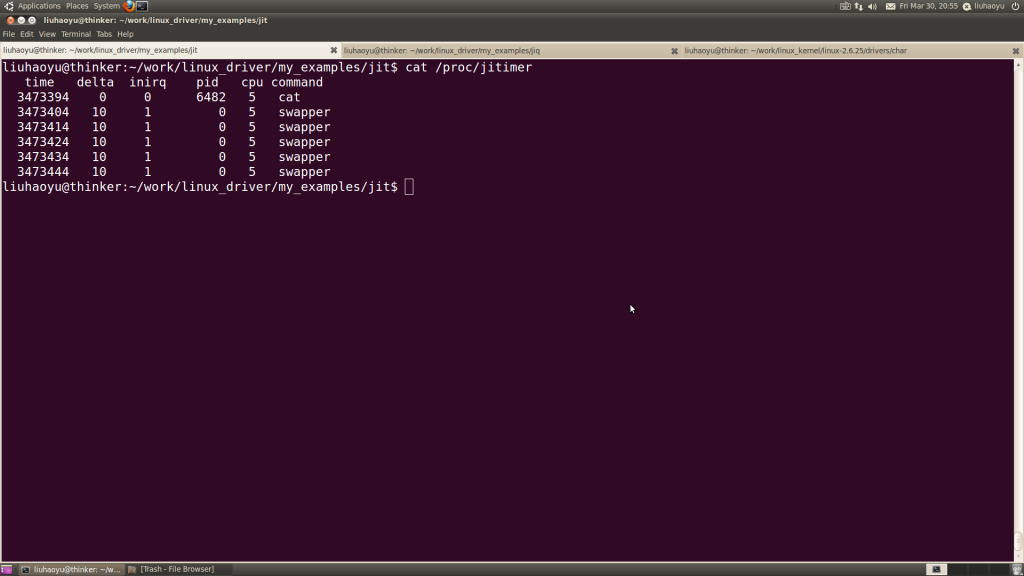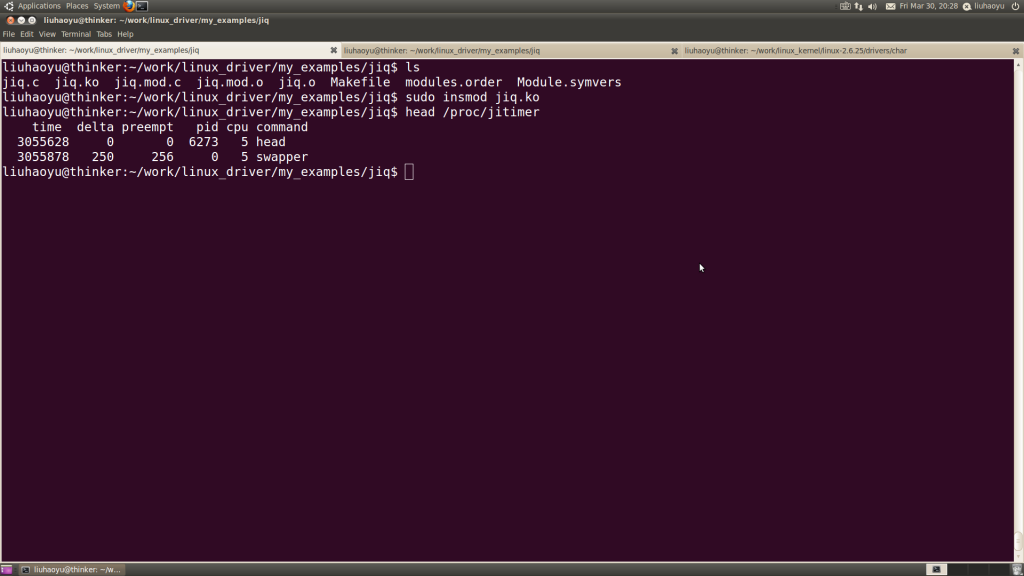LDD3源码分析之时间与延迟操作
来源:互联网 发布:手机上淘宝联盟怎么用 编辑:程序博客网 时间:2024/05/02 04:40
转自:http://blog.csdn.net/liuhaoyutz/article/details/7412931
本人在android内核中也验证过了这些例子,确实可用!好的基础文章值得分享!
LDD3源码路径:examples/misc-modules/jit.c examples/misc-modules/jiq.c
本文分析LDD3第7章的示例程序jit.c和jiq.c,并给出了解决编译jiq.c文件时出现的错误的方法。
一、jit.c文件分析
jit.c程序是一个综合性的演示程序,涉及操作时间和延迟的各种技术。为了使程序代码最少,jit使用动态的/proc文件方式。
按照惯例,我们从模块初始化函数jit_init开始看:
- 263int __init jit_init(void)
- 264{
- 265 create_proc_read_entry("currentime", 0, NULL, jit_currentime, NULL);
- 266 create_proc_read_entry("jitbusy", 0, NULL, jit_fn, (void *)JIT_BUSY);
- 267 create_proc_read_entry("jitsched",0, NULL, jit_fn, (void *)JIT_SCHED);
- 268 create_proc_read_entry("jitqueue",0, NULL, jit_fn, (void *)JIT_QUEUE);
- 269 create_proc_read_entry("jitschedto", 0, NULL, jit_fn, (void *)JIT_SCHEDTO);
- 270
- 271 create_proc_read_entry("jitimer", 0, NULL, jit_timer, NULL);
- 272 create_proc_read_entry("jitasklet", 0, NULL, jit_tasklet, NULL);
- 273 create_proc_read_entry("jitasklethi", 0, NULL, jit_tasklet, (void *)1);
- 274
- 275 return 0; /* success */
- 276}
jit_init共调用了8次create_proc_read_entry函数,我们在《LDD3源码分析之调试技术》一文中分析过这个函数,该函数用来创建一个只读的/proc入口项,其函数原型如下:
- struct proc_dir_entry *create_proc_read_entry(const char *name,
- mode_t mode,
- struct proc_dir_entry *base,
- read_proc_t *read_proc,
- void *data)
name是要创建的文件名称;
mode是该文件的保护掩码(传入0表示使用系统默认值);
base指定该文件所在的目录(如果base为NULL,则该文件将创建在/proc根目录下);
read_proc是实现该文件的读操作的函数;
data是传递给read_proc的参数。
这里我们重点看read_proc函数。为了创建一个只读的/proc文件,驱动程序必须实现一个函数,用于在读取文件时生成数据,这个函数称为read_proc。当某个进程读取这个/proc文件时(使用read系统调用),就会调用相应驱动程序的read_proc函数。
read_proc函数的原型如下:
int (*read_proc)(char *page, char **start, off_t off, int count, int *eof, void *data)这个函数的参数比较难理解,这里我偷下懒,直接把文档Linux Kernel Procfs Guide上对这个函数的解释复制过来,大家自己看。另外,LDD3中文版,翻译上有许多不对的地方,建议大家看英文版的描述。
The read function is a call back function that allows userland processes to read data
from the kernel.
The read function should write its information into the page. For proper use, the function should start writing at an offset ofoffinpage and write at most count bytes, but because most read functions are quite simple and only return a small amount of information, these two parameters are usually ignored (it breaks pagers like more and less, but cat still works).
If the off and count parameters are properly used,eofshould be used to signal that the end of the file has been reached by writing 1 to the memory locationeofpoints to.
The parameter start doesn’t seem to be used anywhere in the kernel. Thedata
parameter can be used to create a single call back function for several files.
The read_func function must return the number of bytes written into thepage.
理解了create_proc_read_entry和read_proc函数,我们就可以来看jit_init函数都完成了哪些工作了。8次调用create_proc_read_entry函数,也就是说,jit_init创建了8个/proc入口项,文件名、read_proc函数以及传递给read_proc函数的参数的如下:
/proc/currentime jit_currentime NULL
/proc/jitbusy jit_fn JIT_BUSY
/proc/jitsched jit_fn JIT_SCHED
/proc/jitqueue jit_fn JIT_QUEUE
/proc/jitschedto jit_fn JIT_SCHEDTO
/proc/jitimer jit_timer NULL
/proc/jitasklet jit_tasklet NULL
/proc/jitasklethi jit_tasklet 1
创建了这些模块入口项之后,jit模块的初始化工作就完成了。下面我们按照LDD3讲的顺序,依次看每个/proc入口项完成什么工作。
首先来看/proc/currentime,它对应的read_proc函数是jit_currentime,其代码如下:
- 91/*
- 92 * This file, on the other hand, returns the current time forever
- 93 */
- 94int jit_currentime(char *buf, char **start, off_t offset,
- 95 int len, int *eof, void *data)
- 96{
- 97 struct timeval tv1;
- 98 struct timespec tv2;
- 99 unsigned long j1;
- 100 u64 j2;
- 101
- 102 /* get them four */
- 103 j1 = jiffies;
- 104 j2 = get_jiffies_64();
- 105 do_gettimeofday(&tv1);
- 106 tv2 = current_kernel_time();
- 107
- 108 /* print */
- 109 len=0;
- 110 len += sprintf(buf,"0x%08lx 0x%016Lx %10i.%06i\n"
- 111 "%40i.%09i\n",
- 112 j1, j2,
- 113 (int) tv1.tv_sec, (int) tv1.tv_usec,
- 114 (int) tv2.tv_sec, (int) tv2.tv_nsec);
- 115 *start = buf;
- 116 return len;
- 117}
jit_currentime函数以多种形式返回当前时间。
97 - 98行,定义了一个timeval类型的变量tv1和一个timespec类型的变量tv2,这两个结构体都定义在linux/time.h中:
- struct timeval {
- time_t tv_sec; /* seconds */
- suseconds_t tv_usec; /* microseconds */
- };
- struct timespec {
- time_t tv_sec; /* seconds */
- long tv_nsec; /* nanoseconds */
- };
用户空间表述时间就是使用这两个结构体,timeval使用秒和毫秒,timespec使用秒和纳秒,timeval出现的更早,也更常用。
103行,将当前jiffies值保存在j1中,注意,j1是unsigned long类型变量。
104行,调用get_jiffies_64函数,取得64位的jiffies值。
105行,调用do_gettimeofday函数,把当前jiffies值转换为timeval类型保存在tv1中。
106行,调用current_kernel_time函数取得当前jiffies值对应的timespec类型,保存在tv2中。
110 - 114行,将4种形式的时间值保存在buf指向的内存页中。
由上面的分析可见,当读/proc/currentime文件时,会打印4种形式的时间值。在我的机器上测试现象如下图所示:

接下来我们看jit_fn函数,/proc/jitbusy、/proc/jitsched、/proc/jitqueue、/proc/jitschedto四个文件的read_proc函数都是jit_fn,所不同的是,读这四个文件时,会分别传递给jit_fn四个不同的参数JIT_BUSY、JIT_SCHED、JIT_QUEUE、JIT_SCHEDTO。函数代码如下:
- 44/* use these as data pointers, to implement four files in one function */
- 45enum jit_files {
- 46 JIT_BUSY,
- 47 JIT_SCHED,
- 48 JIT_QUEUE,
- 49 JIT_SCHEDTO
- 50};
- 51
- 52/*
- 53 * This function prints one line of data, after sleeping one second.
- 54 * It can sleep in different ways, according to the data pointer
- 55 */
- 56int jit_fn(char *buf, char **start, off_t offset,
- 57 int len, int *eof, void *data)
- 58{
- 59 unsigned long j0, j1; /* jiffies */
- 60 wait_queue_head_t wait;
- 61
- 62 init_waitqueue_head (&wait);
- 63 j0 = jiffies;
- 64 j1 = j0 + delay;
- 65
- 66 switch((long)data) {
- 67 case JIT_BUSY:
- 68 while (time_before(jiffies, j1))
- 69 cpu_relax();
- 70 break;
- 71 case JIT_SCHED:
- 72 while (time_before(jiffies, j1)) {
- 73 schedule();
- 74 }
- 75 break;
- 76 case JIT_QUEUE:
- 77 wait_event_interruptible_timeout(wait, 0, delay);
- 78 break;
- 79 case JIT_SCHEDTO:
- 80 set_current_state(TASK_INTERRUPTIBLE);
- 81 schedule_timeout (delay);
- 82 break;
- 83 }
- 84 j1 = jiffies; /* actual value after we delayed */
- 85
- 86 len = sprintf(buf, "%9li %9li\n", j0, j1);
- 87 *start = buf;
- 88 return len;
- 89}
44 - 50行,定义了JIT_BUSY、JIT_SCHED、JIT_QUEUE、JIT_SCHEDTO四个枚举值,分别对应0,1,2,3。
59行,定义了两个unsigned long类型变量j0, j1,用来保存jiffies值。
60 - 62行,定义并初始化了等待队列头wait。
63行,将j0设置为当前jiffies值。
64行,将j1设置为j0 + delay。delay默认值在37行定义为HZ,也可以在命令行指定。
67 - 70行,如果传递给jit_fn的参数是JIT_BUSY,也就是说用户在读/proc/jitbusy文件,此时采用忙等待的方式延迟delay长度的时钟滴答。time_before(jiffies, j1)宏在jiffies小于j1的情况下为真。cpu_relax函数不做任何事情。
因为内核头文件中将jiffies声明为volatile型变量,所以每次C代码访问它时都会重新读取它,因此该循环可以直到延迟的作用。尽管也是正确的实现,但这个忙等待会严重降低系统性能。如果我们没有将内核配置为抢占型的,那么这个循环将在延迟期间独占处理器,在j1所代表的时间到达之前,系统看起来就像死掉了一样。而如果我们将内核配置为可抢占型的,则问题不会那么严重,这是因为除非代码拥有一个锁,否则处理器的时间还可以用作他用。但是在抢占式系统中,忙等待仍然有些浪费。
更糟糕的是,如果在进入while循环之前,禁止了中断,jiffies值就得不到更新,那么while循环的判定条件就永远为真了。
下图是测试/proc/jitbusy的过程:

上图中,第一次执行”dd bs=20 count=5 < /proc/jitbusy”时,是在系统负载比较小的情况下。第二次执行”dd bs=20 count=5 < /proc/jitbusy”时,在另外一个终端下执行了LDD3提供的load50程序,该程序用来增加系统负载。
从上图中的输出内容可以看出,当系统负载较小时,每次读操作延迟恰好是1秒(1000个jiffies),而下一次读操作会在前一个结束后立即执行。但是,当系统负载较大时,每个读操作的延迟恰好是1秒,但是下一次读操作可能会5秒后才会执行。
我们回到jit_fn函数继续往下看。
71 - 75行,如果传递给jit_fn的参数是JIT_SCHED,也就是说用户在读/proc/jitsched文件,此时如果time_before(jiffies, j1)宏为真,则调用schedule函数让出处理器。
虽然这种延迟技术在等待时放弃了CPU,但是性能仍然不理想。当前进程虽然放弃了CPU,但是它仍然在运行队列中,如果系统中只有一个可运行进程,则该进程又会立即运行,而空闲任务(进程号为0,称为swapper)从来不会运行。在系统空闲时运行swapper可以减轻处理器负载,延长处理器寿命,降低电量消耗。
下图是测试/proc/jitsched的过程:

上图中,第一次执行”dd bs=20 count=5 < /proc/jitsched”时,是在系统负载比较小的情况下。第二次执行”dd bs=20 count=5 < /proc/jitsched”时,在另外一个终端下执行了load50程序增加系统负载。可以看出,在系统负载较大时,读操作的延迟比所请求的延迟时间长几个时钟滴答,系统越忙,这个问题越突出。当一个进程使用schedule释放处理器后,不能保证在进程需要时很快就能得到处理器。
因此,除了影响系统整体性能外,使用schedule延迟的方法对驱动程序需求来讲并不安全。
我们再回到jit_fn函数,76 - 78行,如果传递给jit_fn的参数是JIT_QUEUE,也就是说用户在读/proc/jitqueue文件,则调用wait_event_interruptible_timeout(wait, 0, delay)函数在等待队列wait上休眠,但是会在指定的等待时间到期时返回。在到期之前,如果进程收到信号也会退出休眠返回。
下图是测试/proc/jitqueue的过程:

从上图可以看出,即使是在高负载的系统上,对/proc/jitqueue的读取也将得到接近优化的结果。
回到jit_fn函数,现在看79 - 82行,如果传递给jit_fn的参数是JIT_SCHEDTO,也就是说用户在读/proc/schedto文件,则在80行调用set_current_state将进程状态设置为TASK_INTERRUPTIBLE,然后在81行调用schedule_timeout (delay),schedule_timeout函数让出处理器,并等待delay指定的时间。实际上wait_event_interruptible_timeout函数在内部就是利用了schedule_timeout函数。
使用schedule_timeout方式延迟,性能与使用wait_event_interruptible_timeout相似,但是可以避免声明和使用多余的等待队列。
下图是测试/proc/schedto文件的过程:

从上图打印的信息可以看出,即使是在高负载的系统上,对/proc/schedto的读取也将得到接近优化的结果。
到此,jit_fn函数我们就分析完了。下面我们来看jit_timer函数,它对应/proc/jitimer其代码如下:
- 155/* the /proc function: allocate everything to allow concurrency */
- 156int jit_timer(char *buf, char **start, off_t offset,
- 157 int len, int *eof, void *unused_data)
- 158{
- 159 struct jit_data *data;
- 160 char *buf2 = buf;
- 161 unsigned long j = jiffies;
- 162
- 163 data = kmalloc(sizeof(*data), GFP_KERNEL);
- 164 if (!data)
- 165 return -ENOMEM;
- 166
- 167 init_timer(&data->timer);
- 168 init_waitqueue_head (&data->wait);
- 169
- 170 /* write the first lines in the buffer */
- 171 buf2 += sprintf(buf2, " time delta inirq pid cpu command\n");
- 172 buf2 += sprintf(buf2, "%9li %3li %i %6i %i %s\n",
- 173 j, 0L, in_interrupt() ? 1 : 0,
- 174 current->pid, smp_processor_id(), current->comm);
- 175
- 176 /* fill the data for our timer function */
- 177 data->prevjiffies = j;
- 178 data->buf = buf2;
- 179 data->loops = JIT_ASYNC_LOOPS;
- 180
- 181 /* register the timer */
- 182 data->timer.data = (unsigned long)data;
- 183 data->timer.function = jit_timer_fn;
- 184 data->timer.expires = j + tdelay; /* parameter */
- 185 add_timer(&data->timer);
- 186
- 187 /* wait for the buffer to fill */
- 188 wait_event_interruptible(data->wait, !data->loops);
- 189 if (signal_pending(current))
- 190 return -ERESTARTSYS;
- 191 buf2 = data->buf;
- 192 kfree(data);
- 193 *eof = 1;
- 194 return buf2 - buf;
- 195}
159行,定义了jit_data结构体指针变量data,jit_data结构体定义如下:
- 126/* This data structure used as "data" for the timer and tasklet functions */
- 127struct jit_data {
- 128 struct timer_list timer;
- 129 struct tasklet_struct tlet;
- 130 int hi; /* tasklet or tasklet_hi */
- 131 wait_queue_head_t wait;
- 132 unsigned long prevjiffies;
- 133 unsigned char *buf;
- 134 int loops;
- 135};
167行,调用init_timer初始化定时器data->timer。
168行,调用init_waitqueue_head初始化等待队列头data->wait。
171行,向buf2中写入标题头,同时更新buf2的值。
172行,向buf2中写入相关数据,同时更新buf2的值。
177 - 179行,初始化data->prevjiffies为当前jiffies值,data->buf指向buf2,data->loops设置为JIT_ASYNC_LOOPS,JIT_ASYNC_LOOPS在136行定义为5。
181 - 185行,设置和注册定时器dev->timer。定时器函数为jit_timer_fn,传递给该函数的参数为data变量,定时器等待时间为j+tdelay,最后调用add_timer将定时器注册到系统中,此时,即启动了定时器。
188行,在data->wait上休眠等待,注意唤醒条件是data->loops变为0。
193行,将*eof设置为1,表示读/proc/jitimer文件结束。
下面该分析定时器函数jit_timer_fn了,其代码如下:
- 138void jit_timer_fn(unsigned long arg)
- 139{
- 140 struct jit_data *data = (struct jit_data *)arg;
- 141 unsigned long j = jiffies;
- 142 data->buf += sprintf(data->buf, "%9li %3li %i %6i %i %s\n",
- 143 j, j - data->prevjiffies, in_interrupt() ? 1 : 0,
- 144 current->pid, smp_processor_id(), current->comm);
- 145
- 146 if (--data->loops) {
- 147 data->timer.expires += tdelay;
- 148 data->prevjiffies = j;
- 149 add_timer(&data->timer);
- 150 } else {
- 151 wake_up_interruptible(&data->wait);
- 152 }
- 153}
在定时器函数jit_timer_fn中,首先向data->buf中写入相关数据,然后判断data->loops的值是否为0,如果不为0,重新设置相关参数并再次启动定时器;如果data->loops的值变为0,则唤醒等待队列data->wait上的进程。
测试/proc/jitimer的过程如下图所示:

下面我们来看jit_tasklet函数,该函数对应的文件是/proc/ jitasklet和/proc/ jitasklethi,代码如下:
- 216/* the /proc function: allocate everything to allow concurrency */
- 217int jit_tasklet(char *buf, char **start, off_t offset,
- 218 int len, int *eof, void *arg)
- 219{
- 220 struct jit_data *data;
- 221 char *buf2 = buf;
- 222 unsigned long j = jiffies;
- 223 long hi = (long)arg;
- 224
- 225 data = kmalloc(sizeof(*data), GFP_KERNEL);
- 226 if (!data)
- 227 return -ENOMEM;
- 228
- 229 init_waitqueue_head (&data->wait);
- 230
- 231 /* write the first lines in the buffer */
- 232 buf2 += sprintf(buf2, " time delta inirq pid cpu command\n");
- 233 buf2 += sprintf(buf2, "%9li %3li %i %6i %i %s\n",
- 234 j, 0L, in_interrupt() ? 1 : 0,
- 235 current->pid, smp_processor_id(), current->comm);
- 236
- 237 /* fill the data for our tasklet function */
- 238 data->prevjiffies = j;
- 239 data->buf = buf2;
- 240 data->loops = JIT_ASYNC_LOOPS;
- 241
- 242 /* register the tasklet */
- 243 tasklet_init(&data->tlet, jit_tasklet_fn, (unsigned long)data);
- 244 data->hi = hi;
- 245 if (hi)
- 246 tasklet_hi_schedule(&data->tlet);
- 247 else
- 248 tasklet_schedule(&data->tlet);
- 249
- 250 /* wait for the buffer to fill */
- 251 wait_event_interruptible(data->wait, !data->loops);
- 252
- 253 if (signal_pending(current))
- 254 return -ERESTARTSYS;
- 255 buf2 = data->buf;
- 256 kfree(data);
- 257 *eof = 1;
- 258 return buf2 - buf;
- 259}
jit_tasklet的实现与前面分析的jit_timer很类似,相同的地方这里我们不仔细分析了,这里重点看一下两个函数不同的地方。
243行,调用tasklet_init初始化data->tlet,指定tasklet函数为jit_tasklet_fn,交将data作为参数传递给jit_tasklet_fn。
245 - 246行,如果hi为1,则使用tasklet_hi_schedule函数以高优先级调度data->tlet执行。当软件中断处理程序运行时,它会在处理其他软件中断(包括普通的tasklet)之前,处理高优先级的tasklet。
247 - 248行,如果hi为0,则使用tasklet_schedule调度data->tlet执行。
251行,在data->wait上休眠等待,注意唤醒条件是data->loops变为0。
257行,将*eof设置为1,表示读/proc/ jitasklet或/proc/ jitasklethi文件结束。
下面看tasklet函数jit_tasklet_fn:
- 197void jit_tasklet_fn(unsigned long arg)
- 198{
- 199 struct jit_data *data = (struct jit_data *)arg;
- 200 unsigned long j = jiffies;
- 201 data->buf += sprintf(data->buf, "%9li %3li %i %6i %i %s\n",
- 202 j, j - data->prevjiffies, in_interrupt() ? 1 : 0,
- 203 current->pid, smp_processor_id(), current->comm);
- 204
- 205 if (--data->loops) {
- 206 data->prevjiffies = j;
- 207 if (data->hi)
- 208 tasklet_hi_schedule(&data->tlet);
- 209 else
- 210 tasklet_schedule(&data->tlet);
- 211 } else {
- 212 wake_up_interruptible(&data->wait);
- 213 }
- 214}
该函数的功能与前面介绍的定时器函数jit_timer_fn非常像,只不过把调度定时器的操作换成了调度tasklet的函数。
下图是测试/proc/ jitasklet或/proc/ jitasklethi的过程:

至此,jit.c文件我们就全部分析完了。
二、jiq.c文件分析
LDD3第7章涉及的代码还有一个jiq.c文件,这个文件主要演示了等待队列的用法。下面是jiq模块初始化函数jiq_init的代码:
- 240static int jiq_init(void)
- 241{
- 242
- 243 /* this line is in jiq_init() */
- 244 INIT_WORK(&jiq_work, jiq_print_wq, &jiq_data);
- 245
- 246 create_proc_read_entry("jiqwq", 0, NULL, jiq_read_wq, NULL);
- 247 create_proc_read_entry("jiqwqdelay", 0, NULL, jiq_read_wq_delayed, NULL);
- 248 create_proc_read_entry("jitimer", 0, NULL, jiq_read_run_timer, NULL);
- 249 create_proc_read_entry("jiqtasklet", 0, NULL, jiq_read_tasklet, NULL);
- 250
- 251 return 0; /* succeed */
- 252}
244行,初始化一个工作jiq_work,其工作函数是jiq_print_wq,jiq_data是传递给该函数的参数。jiq_work是work_struct类型的变量,struct work_struct在linux/workqueue.h文件中定义如下:
- struct work_struct {
- atomic_long_t data;
- #define WORK_STRUCT_PENDING 0 /* T if work item pending execution */
- #define WORK_STRUCT_FLAG_MASK (3UL)
- #define WORK_STRUCT_WQ_DATA_MASK (~WORK_STRUCT_FLAG_MASK)
- struct list_head entry;
- work_func_t func;
- #ifdef CONFIG_LOCKDEP
- struct lockdep_map lockdep_map;
- #endif
- };
jiq_data是一个全局变量,其定义如下:
- 63static struct clientdata {
- 64 int len;
- 65 char *buf;
- 66 unsigned long jiffies;
- 67 long delay;
- 68} jiq_data;
246 - 249行,创建4个/proc只读接口,它们分别是/proc/ jiqwq、/proc/ jiqwqdelay、/proc/ jitimer、/proc/ jiqtasklet,这4个文件对应的read_proc函数分别是jiq_read_wq、jiq_read_wq_delayed、jiq_read_run_timer、jiq_read_tasklet。
首先来看jiq_read_wq函数的实现:
- 129static int jiq_read_wq(char *buf, char **start, off_t offset,
- 130 int len, int *eof, void *data)
- 131{
- 132 DEFINE_WAIT(wait);
- 133
- 134 jiq_data.len = 0; /* nothing printed, yet */
- 135 jiq_data.buf = buf; /* print in this place */
- 136 jiq_data.jiffies = jiffies; /* initial time */
- 137 jiq_data.delay = 0;
- 138
- 139 prepare_to_wait(&jiq_wait, &wait, TASK_INTERRUPTIBLE);
- 140 schedule_work(&jiq_work);
- 141 schedule();
- 142 finish_wait(&jiq_wait, &wait);
- 143
- 144 *eof = 1;
- 145 return jiq_data.len;
- 146}
jiq_read_wq函数中使用的是共享工作队列,而不是进程专用的工作队列,共享工作队列更节约系统资源。该函数的休眠采用的是手工休眠。
132行,使用DEFINE_WAIT宏定义一个等待队列入口wait。
134 - 137行,对jiq_data进行初始化。
139行,调用prepare_to_wait函数将wait加入到等待队列jiq_wait中,并把进程状态设置为TASK_INTERRUPTIBLE。
140行,调用schedule_work将jiq_work提交到系统提供的共享工作队列中。
141行,调用schedule函数,让出处理器,此后,进程就在等待队列jiq_wait中休眠。
142行,休眠被唤醒后,调用finish_wait做一些清理工作。
144行,将*eof设置为1,表明已经读到/proc/jiqwq的结束处。
把工作jiq_work提交给共享工作队列后,在此后的某一时间,工作函数jiq_print_wq就会执行,该函数代码如下:
- 111/*
- 112 * Call jiq_print from a work queue
- 113 */
- 114static void jiq_print_wq(void *ptr)
- 115{
- 116 struct clientdata *data = (struct clientdata *) ptr;
- 117
- 118 if (! jiq_print (ptr))
- 119 return;
- 120
- 121 if (data->delay)
- 122 schedule_delayed_work(&jiq_work, data->delay);
- 123 else
- 124 schedule_work(&jiq_work);
- 125}
工作函数jiq_print_wq的核心代码在jiq_print函数中,如果该函数返回0,则退出。如果返回非0值,说明还需要再次调用该工作。如果jiq_print函数返回非0值,根据data->delay的值是否为0,分别采用schedule_delayed_work和schedule_work,以延迟和非延迟的方式重新调度工作。
jiq_print函数定义如下:
- 78/*
- 79 * Do the printing; return non-zero if the task should be rescheduled.
- 80 */
- 81static int jiq_print(void *ptr)
- 82{
- 83 struct clientdata *data = ptr;
- 84 int len = data->len;
- 85 char *buf = data->buf;
- 86 unsigned long j = jiffies;
- 87
- 88 if (len > LIMIT) {
- 89 wake_up_interruptible(&jiq_wait);
- 90 return 0;
- 91 }
- 92
- 93 if (len == 0)
- 94 len = sprintf(buf," time delta preempt pid cpu command\n");
- 95 else
- 96 len =0;
- 97
- 98 /* intr_count is only exported since 1.3.5, but 1.99.4 is needed anyways */
- 99 len += sprintf(buf+len, "%9li %4li %3i %5i %3i %s\n",
- 100 j, j - data->jiffies,
- 101 preempt_count(), current->pid, smp_processor_id(),
- 102 current->comm);
- 103
- 104 data->len += len;
- 105 data->buf += len;
- 106 data->jiffies = j;
- 107 return 1;
- 108}
88 - 91行,如果打印的信息已经超过了LIMIT()的限制,则唤醒等待队列jiq_wait上的进程,并返回0,表示不需要再次调度该工作。
93 - 102行,打印相关信息。
104 - 107行,更新jiq_data的信息。
108行,返回1,表明还需要再次调度该工作。
下图是对/proc/jiqwq的测试过程:

下面我们来看jiq_read_wq_delayed函数,其代码如下:
- 149static int jiq_read_wq_delayed(char *buf, char **start, off_t offset,
- 150 int len, int *eof, void *data)
- 151{
- 152 DEFINE_WAIT(wait);
- 153
- 154 jiq_data.len = 0; /* nothing printed, yet */
- 155 jiq_data.buf = buf; /* print in this place */
- 156 jiq_data.jiffies = jiffies; /* initial time */
- 157 jiq_data.delay = delay;
- 158
- 159 prepare_to_wait(&jiq_wait, &wait, TASK_INTERRUPTIBLE);
- 160 schedule_delayed_work(&jiq_work, delay);
- 161 schedule();
- 162 finish_wait(&jiq_wait, &wait);
- 163
- 164 *eof = 1;
- 165 return jiq_data.len;
- 166}
这个函数与前面分析的jiq_read_wq非常相似,区别是这里采用延迟方式调度工作。这里我只看两个函数不同的地方,如果有不明白的,参考jiq_read_wq理解。
157行,因为要采用延迟方式,设置jiq_data.delay的值为delay,其默认值为1,可以通过命令行传递参数修改。
160行,schedule_delayed_work以延迟模式将工作提交到工作队列。
把工作jiq_work提交给共享工作队列后,在此后的某一时间,工作函数jiq_print_wq就会执行,该函数我们前面已经分析过,/proc/jiqwqdelay与/proc/jiqwq的区别是因为指定了jiq_data.delay的值为非0值,所以121行,如果需要再次调度工作,还是用延迟模式调度。
下图是测试/proc/jiqwqdelay的过程:

下面我们来看jiq_read_run_timer函数,这个函数使用的是定时器,其代码如下:
- 212static int jiq_read_run_timer(char *buf, char **start, off_t offset,
- 213 int len, int *eof, void *data)
- 214{
- 215
- 216 jiq_data.len = 0; /* prepare the argument for jiq_print() */
- 217 jiq_data.buf = buf;
- 218 jiq_data.jiffies = jiffies;
- 219
- 220 init_timer(&jiq_timer); /* init the timer structure */
- 221 jiq_timer.function = jiq_timedout;
- 222 jiq_timer.data = (unsigned long)&jiq_data;
- 223 jiq_timer.expires = jiffies + HZ; /* one second */
- 224
- 225 jiq_print(&jiq_data); /* print and go to sleep */
- 226 add_timer(&jiq_timer);
- 227 interruptible_sleep_on(&jiq_wait); /* RACE */
- 228 del_timer_sync(&jiq_timer); /* in case a signal woke us up */
- 229
- 230 *eof = 1;
- 231 return jiq_data.len;
- 232}
有了前面分析的基础,我们看这个函数应该比较轻松,因为大部分代码和前面分析过的代码是一样的。
216 - 218行,初始化jiq_data。
220 - 223行,初始化定时器jiq_timer,定时器函数是jiq_timedout。
225行,调用jiq_print打印标题栏和一行信息。
226行,启动定时器。
227行,进程在jiq_wait上休眠等待。
定时器函数是jiq_timedout的代码如下:
- 205static void jiq_timedout(unsigned long ptr)
- 206{
- 207 jiq_print((void *)ptr); /* print a line */
- 208 wake_up_interruptible(&jiq_wait); /* awake the process */
- 209}
该定时器函数只执行一次,207行打印一行信息,208行唤醒等待进程。
下图是测试/proc/jitimer的过程:

下面我们看jiq_read_tasklet函数,这个函数使用的是tasklet,其代码如下:
- 182static int jiq_read_tasklet(char *buf, char **start, off_t offset, int len,
- 183 int *eof, void *data)
- 184{
- 185 jiq_data.len = 0; /* nothing printed, yet */
- 186 jiq_data.buf = buf; /* print in this place */
- 187 jiq_data.jiffies = jiffies; /* initial time */
- 188
- 189 tasklet_schedule(&jiq_tasklet);
- 190 interruptible_sleep_on(&jiq_wait); /* sleep till completion */
- 191
- 192 *eof = 1;
- 193 return jiq_data.len;
- 194}
189行,调度jiq_tasklet。
190行,进程在jiq_wait上休眠。
jiq_tasklet在第75行定义:
- 75static DECLARE_TASKLET(jiq_tasklet, jiq_print_tasklet, (unsigned long)&jiq_data);
tasklet函数是jiq_print_tasklet,其定义如下:
- 171/*
- 172 * Call jiq_print from a tasklet
- 173 */
- 174static void jiq_print_tasklet(unsigned long ptr)
- 175{
- 176 if (jiq_print ((void *) ptr))
- 177 tasklet_schedule (&jiq_tasklet);
- 178}
调用jiq_print打印信息,如果jiq_print返回非0值,重新调度task_let。
测试/proc/jiqtasklet的过程如下图所示:

三、编译jiq模块时出现的问题
在编译jiq模块过程中,出现如下图所示错误:

这是因为linux/config.h在2.6.32-38-generic-pae内核中不存在了,解决方法是直接把jiq的第18行删除即可。再次编译,出现如下错误:

这是因为在2.6.32-38-generic-pae内核中,INIT_WORK宏的定义发生了变化,只能接受两个参数,但是LDD3传递了3个参数。解决办法是把243行
- 243 INIT_WORK(&jiq_work, jiq_print_wq, &jiq_data);
替换为
- 243 INIT_WORK(&jiq_work, jiq_print_wq);
这样替换完成后,还有几个连锁反应需要处理。因为LDD3中的本意是把jiq_data作为参数传递给jiq_print_wq函数。现在新的INIT_WORK中无法传递参数了,所以我们需要修改jiq_print_wq函数,手动把jiq_data传递过去。修改后的jiq_print_wq代码如下:
- 113static void jiq_print_wq(struct work_struct *work)
- 114{
- 115 struct clientdata *data = (struct clientdata *) &jiq_data;
- 116
- 117 if (! jiq_print (&jiq_data))
- 118 return;
- 119
- 120 if (data->delay)
- 121 schedule_delayed_work(&jiq_work, data->delay);
- 122 else
- 123 schedule_work(&jiq_work);
- 124}
与原来相比,共修改了3个地方。
113行,参数类型改为work_struck结构指针,这是新内核定义的参数类型。
115行,直接使用全局变量jiq_data,原来是通过参数传递的。
117行,直接使用全局变量jiq_data,原来是通过参数传递的。
修改后,再编译,能编译通过,但仍有问题,如下图所示:

这是因为,在2.6.32-38-generic-pae内核中,schedule_delayed_work函数的定义发生了变化,现在其函数原型是
- int schedule_delayed_work(struct delayed_work *dwork, unsigned long delay)
而在LDD3使用的2.6.10版本的内核中,其函数原型是:
- int fastcall schedule_delayed_work(struct work_struct *work, unsigned long delay)
所以要在新内核上执行schedule_delayed_work,原来的work_struct必须改为delayed_work。
delayed_work结构体定义如下:
- struct delayed_work {
- struct work_struct work;
- struct timer_list timer;
- };
为了使修改的代码最少,我做了如下修改:
1、在第56行定义了一个全局delayed_work结构体变量 jiq_delayed_work;
- 56static struct delayed_work jiq_delayed_work;
2、重新定义jiq_read_wq_delayed函数如下:
- 148static int jiq_read_wq_delayed(char *buf, char **start, off_t offset,
- 149 int len, int *eof, void *data)
- 150{
- 151 DEFINE_WAIT(wait);
- 152 INIT_DELAYED_WORK(&jiq_delayed_work, jiq_print_wq);
- 153
- 154 jiq_data.len = 0; /* nothing printed, yet */
- 155 jiq_data.buf = buf; /* print in this place */
- 156 jiq_data.jiffies = jiffies; /* initial time */
- 157 jiq_data.delay = delay;
- 158
- 159 prepare_to_wait(&jiq_wait, &wait, TASK_INTERRUPTIBLE);
- 160 schedule_delayed_work(&jiq_delayed_work, delay);
- 161 schedule();
- 162 finish_wait(&jiq_wait, &wait);
- 163
- 164 *eof = 1;
- 165 return jiq_data.len;
- 166}
与原来的相比,增加了152行初始化jiq_delayed_work。修改了160行,调度jiq_delayed_work。
3、修改工作函数jiq_print_wq。
- 113static void jiq_print_wq(struct work_struct *work)
- 114{
- 115 struct clientdata *data = (struct clientdata *) &jiq_data;
- 116
- 117 if (! jiq_print (&jiq_data))
- 118 return;
- 119
- 120 if (data->delay)
- 121 schedule_delayed_work(&jiq_delayed_work, data->delay);
- 122 else
- 123 schedule_work(&jiq_work);
- 124}
与原来相比,修改了121行,调度jiq_delayed_work。
修改完成后,编译通过,如下图所示:

- LDD3源码分析之时间与延迟操作
- LDD3源码分析之时间与延迟操作
- LDD3源码分析之时间与延迟操作
- LDD3源码分析之时间与延迟操作
- LDD3源码分析之时间与延迟操作
- LDD3源码分析之时间与延迟操作
- LDD3源码分析之时间与延迟操作
- LDD3源码分析之ioctl操作
- LDD3源码分析之ioctl操作
- LDD3源码分析之ioctl操作
- LDD3源码分析之ioctl操作
- LDD3源码分析之ioctl操作 .
- LDD3源码分析之ioctl操作
- LDD3源码分析之vmalloc
- LDD3源码分析之vmalloc
- LDD3源码分析之vmalloc
- LDD3源码分析之vmalloc
- LDD3源码分析之hello.c与Makefile模板
- Android 相关知识 EditText焦点相关问题
- 动态规划解0-1背包问题
- http协议学习系列
- ubuntu 12.04 64位,安装mysql-workbench问题解决记录
- Android利用ViewFlipper实现屏幕切换动画效果
- LDD3源码分析之时间与延迟操作
- 《C语言接口与实现》实验——环(Ring_T)
- SQL Server 查询处理中的执行顺序
- OpenCV深入学习(6)--直方图之calcHist使用(补)
- 《C语言接口与实现》实验——集合(xref)
- Eclipse里web的依赖工程部署的简便方法
- 设计一个O(n2)时间的算法,找出由n个数组成的序列的最长单调递增子序列。
- 最长公共子序列
- 最小生成树——解题报告


